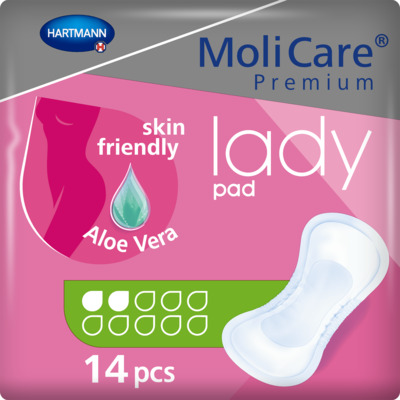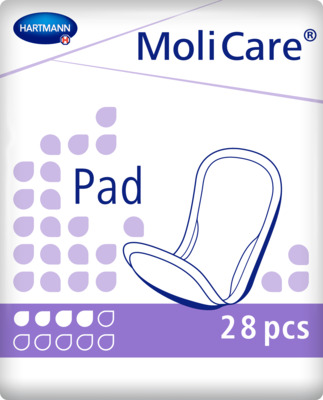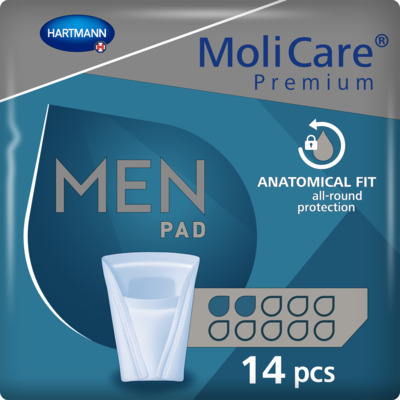Active living
How To Dispose Of Soiled Incontinence Pads Correctly
For those living with or caring for someone with incontinence, you may use incontinence products for protection and security, particularly in social situations. Whilst these products are extremely beneficial, the question of how to dispose of soiled incontinence pads can sometimes prove to be a challenge. In this article, you will learn how to dispose of soiled incontinence pads appropriately, and in an eco-friendly manner.

Handling Incontinence Pads
When living with incontinence, pads are important for improving the quality of life for the wearer. However, when it comes to changing or removing the pads, you should wrap the used pad up in a separate plastic bag, or a yellow recycling bag if possible. Once the incontinence pad has been wrapped up correctly, you can simply pop it in the bin. You shouldn’t flush incontinence pads down the toilet as this can cause blockages.
For light bladder weakness, you can opt for reusable pants. When washing these, go for a gentle detergent and steer clear of fabric softeners, since these can irritate sensitive skin. You should also keep reusable pads separate from the rest of your laundry to avoid spreading germs.
You should also consider using an appropriate disposable system for used incontinence pads in your home. It might seem small, but it can bring big changes! Having a disposal system at the ready can save you from constant trips to the outdoor bin. Use yellow bin bag liners to contain the used incontinence pads, and once the disposal system is filled up, you can then proceed to take it to an outdoor bin. However, make sure that your home disposal bin for soiled incontinence pads is kept airtight to prevent unwanted smells from lingering around your home.
Alternatively, there are scented bin bags that are tailored to store away used incontinence pads and are commonly used for women's pantyliners and baby nappies too. Steer clear of flimsy plastic supermarket bags – they can tear easily and cause unpleasant smells. These disposable bags offer an economical, hassle-free, and smart solution. Plus, they're crafted from recyclable material, a great choice helping to protect the environment. Just remember to neatly fold up the pads before placing them inside the bags.
How to Change Incontinence Pads Easily
Having incontinence pads about your person that are easy to change is particularly important, even for social situations. This is especially helpful if you find it hard to get around. If you are managing heavy incontinence and limited mobility, MoliCare® incontinence pads are the ones to go for as they are easy to change and are comfortable for different skin routines.
If you need to change incontinence pads regularly, you should wear clothes that are easy to remove. Nobody wants to spend ages in the bathroom fumbling with changes. Avoid tight dresses or clothes with a bunch of buttons that take time to undo. You can still dress up without squeezing into awkward clothing!

Using Outdoor Bins to Dispose of Soiled Incontinence Pads
If throwing away incontinence products indoors makes you feel uneasy, you could use an outdoor bin instead. Doing this will make you worry less about unpleasant smells lingering around your home. As mentioned, you should also be aware of the different types of bins, and know which one to dispose of your soiled incontinence pads in.
Carrying a scented bin bag along can help cover up any odours, and no one will suspect you've disposed of a product. Just remember, if you're using public bins, always use a disposable bag. This ensures the product is sealed and won't create an unpleasant odour. And for social outings, be sure to carry spare products.
You never know when or where you might need to change an incontinence product, so being prepared is a smart move.
Being Hygienic Whilst Changing Products
If you are disposing of incontinence pads in a bathroom bin, consider using anti-bacterial sprays or other scented products to hide any unwanted smells. At the same time, when you're changing incontinence pads, you should keep yourself sanitised and wear glove protection. MoliCare®Skin Cleanse Wipes are conveniently small and will do just the job. Using these wipes makes them incredibly versatile for your whole body and excellent for perineal skin care during changes. And remember, never flush these products down the toilet either.
Another thought that may cross your mind whilst handling soiled incontinence pads, is whether double padding is a good idea. Our MoliCare® incontinence products are designed so that you do not need to double pad, because this can otherwise lead to additional issues, and can also affect hygiene.
Washing your hands after use
After you have disposed of any soiled incontinence pads, be sure to wash your hands thoroughly with soap and water, even if you have worn Peha soft latex gloves. This step is essential to stop any bacteria or infection from spreading.
You should also use MoliCare® premium fix long pants since these are specially made to be worn with shaped pads to keep them securely in place. They don't have absorbent abilities on their own, but they prevent your pad from moving.
Dealing with incontinence can be tough and sensitive, but there are solutions available to make managing it easier. Plus, proper disposal of incontinence pads is crucial for good hygiene and stopping the spread of germs. By following these steps, you can ensure your incontinence pads are disposed of in the cleanest way possible.
To learn more about how to handle incontinence pads and other potential substances, follow the government’s advice on handling hazardous materials.
Handle Soiled Incontinence Pads Safely
From this article, you should now be aware of how to dispose of soiled incontinence pads in the UK. Whilst it may seem minor, it is important to know how to dispose of these items correctly to prevent harming yourself or the environment. Wrapping the soiled incontinence pads in a sealed yellow bag, wearing protective clothing, and washing your hands before and after use will prove effective ways towards keeping yourself safe. Knowing more about our top tips on managing incontinence is important for maintaining hygiene through appropriate incontinence pad disposal.

FAQs
How should I dispose of used incontinence pads?
Used incontinence pads should be placed in a suitable disposal bag that is designed for medical waste. Seal the bag tightly to contain any odours and prevent leakage.
Where can I get these special disposal bags for incontinence pads?
You can usually obtain these bags from pharmacies, medical supply stores, or online retailers. Look for bags specifically designed for medical waste disposal.
Should I flush incontinence pads down the toilet?
No, you should never flush incontinence pads down the toilet. Flushing them can cause blockages in the sewage system and harm the environment.
Can I compost incontinence pads?
No, you should not compost incontinence pads. They are not suitable for composting due to their synthetic and absorbent materials.
How often should I change the disposal bag for soiled incontinence pads?
It's recommended to change the disposal bag whenever it's full or after you've disposed of each incontinence pad. This helps maintain hygiene and prevents odours.
Sources

MoliCare® Premium Lady Pad 2 Drops
<h2>Skin Friendly Pant Liners</h2> <p>For women that experience slight incontinence and bladder weakness, across different age groups, it can be a challenge to find the right bladder weakness product that is easy to apply and wear without the worry of potential leakages. Fortunately, we understand this approach, hence why we are happy to offer our MoliCare® Premium Lady Pad 2 drops, that is skin-friendly, Aloe Vera applied, and comes with 14 liners per bag.</p> <h2>Slim and discreet liners</h2> <p>Whether dealing with stress incontinence or urge incontinence, these panty liners offer a discreet and easy solution on the go. Simply place the pad in your underwear and secure it with the adhesive strip for all-round protection. Available in different absorbency levels, MoliCare® bladder weakness products cater to all levels of bladder weakness, ensuring secure care.</p> <h2>Control Bladder Weakness</h2> <p>Enjoy the benefits of these body-shaped absorbent panty liners, designed for women with bladder weakness. The pads offer discreet, reliable protection with features including odour control and fast absorption.</p> <p>With a wide adhesive strip, you can comfortably fix the pad in your regular underwear, providing secure and comfortable fixation. The pads are skin-friendly, featuring soft, breathable materials, including foam cuffs, and a top sheet treated with Aloe Vera.</p> <p>Keeping your skin healthy is a priority, which is why MoliCare® Premium Lady Pads have a skin-neutral pH value of 5.5 and an antibacterial finish. They are also dermatologically tested, offering peace of mind.</p> <h2>Buy pant liners online</h2> <p>Never worry about running out with our convenient order service and fast delivery direct to your door. Enjoy free shipping on orders over £50.</p> <p>If you need assistance, our professional customer service team is here to support you in choosing the right product. Reach out to us today at 0800 028 9470 and experience the comfort and reliability of MoliCare® Premium Lady Pads.</p>
MoliCare® Premium Men Pad 3 Drops (ISO 441ml)
<p><strong>Reliable and discreet incontinence pads for men with an instant-dry feeling</strong></p> <p>Bladder weakness is difficult to live with, the last thing you want to worry about is incontinence protection. That’s why our best-ever MoliCare® premium MEN Pad 3 drops offer an <strong>all-round protection</strong> that keeps everything dry and comfortably in place while fitting discreetly in your regular underwear.</p> <p>The incontinence pad for men quickly <strong>removes urine from the surface up to 86 %* faster than before</strong> and neutralises unpleasant odours to leave you feeling instantly dry and in control thanks to the new <strong>MoliCare SkinGuard</strong>®<strong> Absorbent Core Technology</strong>. This skin-friendly technology not only helps you feel up to 90 %* drier than previous MoliCare® premium<strong> </strong>MEN pads, it also helps to maintain healthy skin and preventing irritation.</p> <p><strong>Engineered for the male anatomy</strong> and dermatologically tested for maximum skin compatibility, these male urinary pads do not contain colour, perfume or latex making them environmentally friendly too.</p> <p>*Compared to last generation</p>
MoliCare® Pad 4 Drops
<h2>Handy MoliCare incontinence pads to carry on the go</h2> <p>Our MoliCare® Pad 4 Drops are an essential product for those experiencing slight incontinence, allowing you to regain control and live your busy and active life without the interference of bladder weakness. Designed for both men and women, this incontinence pad for men and women offers exceptional dryness and protection, ensuring your comfort and confidence.</p> <h2>‘Barely There’ Reassurance and Reliability</h2> <p>The MoliCare® Pad 4 Drops are slimline, discreet, and adjusted to fit your body seamlessly. It fixes securely inside your underwear, providing a ‘barely there’ comfort feel. With its soft and skin-kind fabric, along with a wide adhesive fixing strip on the backsheet, you can go about your day with the assurance of being protected against leakages.</p> <p>The absorbent core effectively prevents your skin from becoming too moist, while the elastic anti-leak edging adds an extra layer of security and peace of mind. Say goodbye to any worries about odours, as the MoliCare® Pad 4 Drops also neutralises odours to keep you fresh and confident throughout the day. Don't let incontinence hold you back from living life to the fullest.</p> <p>Ordering your MoliCare® Pad 4 Drops is hassle-free, as we offer fast delivery direct to your door. With our price match promise, you can trust that you're getting the best value for your money. Plus, enjoy free delivery on all orders over £50.</p> <p>If you need assistance in finding the perfect incontinence product for your needs, our friendly customer care team is here to help. Don't hesitate to reach out to us at 0800 028 9470. Take control of your life with the reliable protection and comfort of the MoliCare® Pad, alongside other <a href="https://www.hartmanndirect.co.uk/incontinence-products/incontinence-pads" style="color:#0563c1; text-decoration:underline">incontinence pads</a>.</p>
